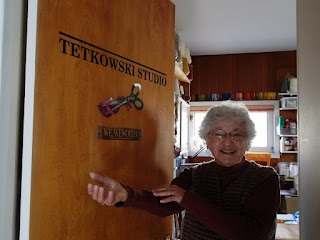 |
| Lee at her dining room table in the house that her husband Clem designed about 70 years ago. She designed and wove the vest that she is wearing |
As long as I can remember, I liked to draw. I was a child of the Depression. We didn't have anything like toys. What I had was a hand-me-down child's roll top desk that had belonged to my sister and brother. I had a pencil and a notebook with a blue watercolor box with a lousy paintbrush that didn't produce much color.
I discovered paper dolls in the Sunday newspaper. I made outfits with little tabs.
 |
| Lee's parents. |
 |
| The stone in Lee's ring was the stone in her father's tie tack. |
She did! When I was a teenager, I asked her to teach me to knit. Mama knitted left handed. I could not work that way. When I was sixteen or seventeen, after I graduated from high school, I had a Saturday job. I saved my money and went to Bamberger's Department Store. They provided free instruction with a yarn purchase. My first project was a beige button-down short sleeved little sweater.
Years later, when I was in Italy, all of the women and big girls there knitted. It was affordable. My daughter Diane learned to knit the Italian way.
 |
| A large piece of fiber that Lee designed and wove |
 |
| Lee and her husband Clem after the war. |
 |
| Lee's plant corner, with a tree weaving |
How did you become a weaver?
How did I get hooked on weaving? In the freshman year of the art education program, I took a little of every art medium, and I loved everything. The first year introduced fabric arts, including batiking and tie dying and a few weeks of learning how to weave. This was the first glimmer of what was to come. The teacher had a whole room of small metal prepared looms already threaded with this white butcher cord. I loved the idea of interlocking threads. I fell in love with fibers. I was the only one who loved it. The other students all hated it. The instructor presented it in a dull way. But I ate a bag lunch and worked on my project alone in the room.
 |
| working at the loom |
What led you and your husband to Italy and how did Buffalo State College establish the Siena program?
 |
| Lee and Clem Tetkowski in Italy |
 |
| another one of Lee's designs |
 |
| Lee and Clem's three children, Mira, Diane, and Neil. |
After that, we took a group of undergraduates to learn about the Renaissance in Italy. They were able to see and learn the culture and the language.
The Siena semester is the oldest study abroad program at the state college. It materialized in September of 1961. From March to April, Clem told me that it would happen. I listened to records and studied Italian. It changed our lives. I fell in love with everything about Italy: the people, the language, the culture, and the air.
 |
| Lee works at her large loom. |
I applied for a sabbatical (from my high school teaching job), and I was refused. We still went to Italy. My golden time was from 1974 until 1976. We had a little Fiat. We spoke the language.
 |
| Lee loves her at-home studio |
 |
| A painting that Lee made in Italy. |
In 1985, I retired. Clem had just been diagnosed with Parkinson's. Clem said, "Let's go to Italy." We went in October and we came home for Thanksgiving.
Since then, I've visited Italy for reunions, a birthday party in a castle. It was catered by a restaurant. It felt so proper to repay my friends in Italy for so many dinners we got invited to. I said to my family, when I'm 85, I want to go to Siena and have a party. It was done for my 86th birthday.
 |
| the shelf in Lee's studio. |




12 comments:
Thank you for this interesting story of this remarkable woman. I enjoy reading it so much!
How interesting to read about Lee! I love her ring from the tie tack!
What a wonderful life Lee has led - enriching and fulfilling .
Very moving, to read her story! I loved learning about her, seeing her art and the other pictures.
I have the pleasure of know Lee and being a part of the Siena alumnae program -having gone in 1969. She is a remarkable woman with so much talent and strength. This was a lovely story
Jackie Martins
I loved this creative journey ,painter weaver and everything beautiful.Lee's journey is inspiring and I love dhow you presented her .It was like she is in the room with me.
Hi Alice, thanks for another great article on people doing extraordinary things. Immagine living a long life doing the things you enjoy the most. You can retire from a job but it is hard to give up what you love to do. Blog on!
Thrilled to see that she is still actively producing art. Thanks for the intorduciton.
I really enjoyed your artist's profile of Lee. As a Siena program alumna, I really likd learning more about this talented lady.
Beautiful Lady! Beautiful art. I am only met Lee ten years ago. What an inspiration she is.
I love the ceramics with her family's handprints. WonderfuL. I also weave as a hobby.
Very nicely done. As a friend of the family, I’ve heard some spin yarns with some of these threads before. But now the story is woven together for me so nicely!
Post a Comment